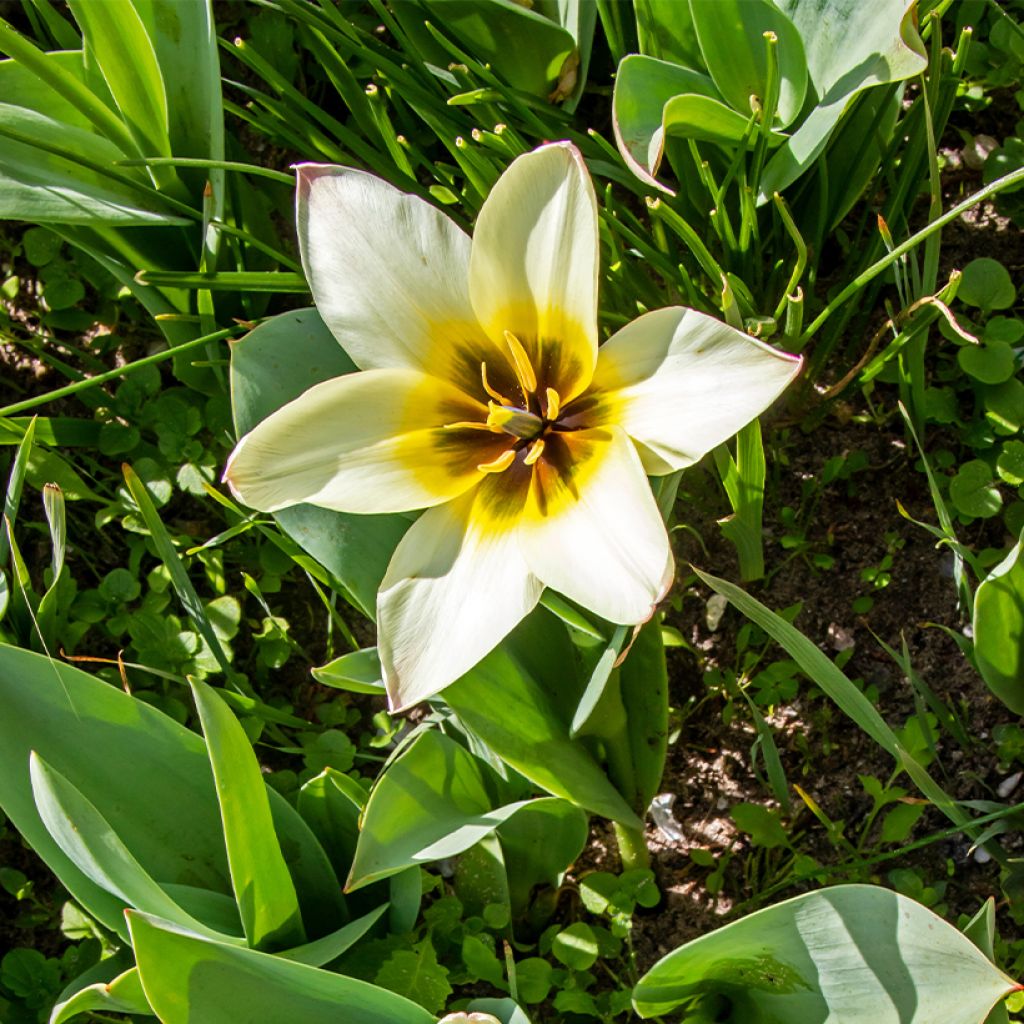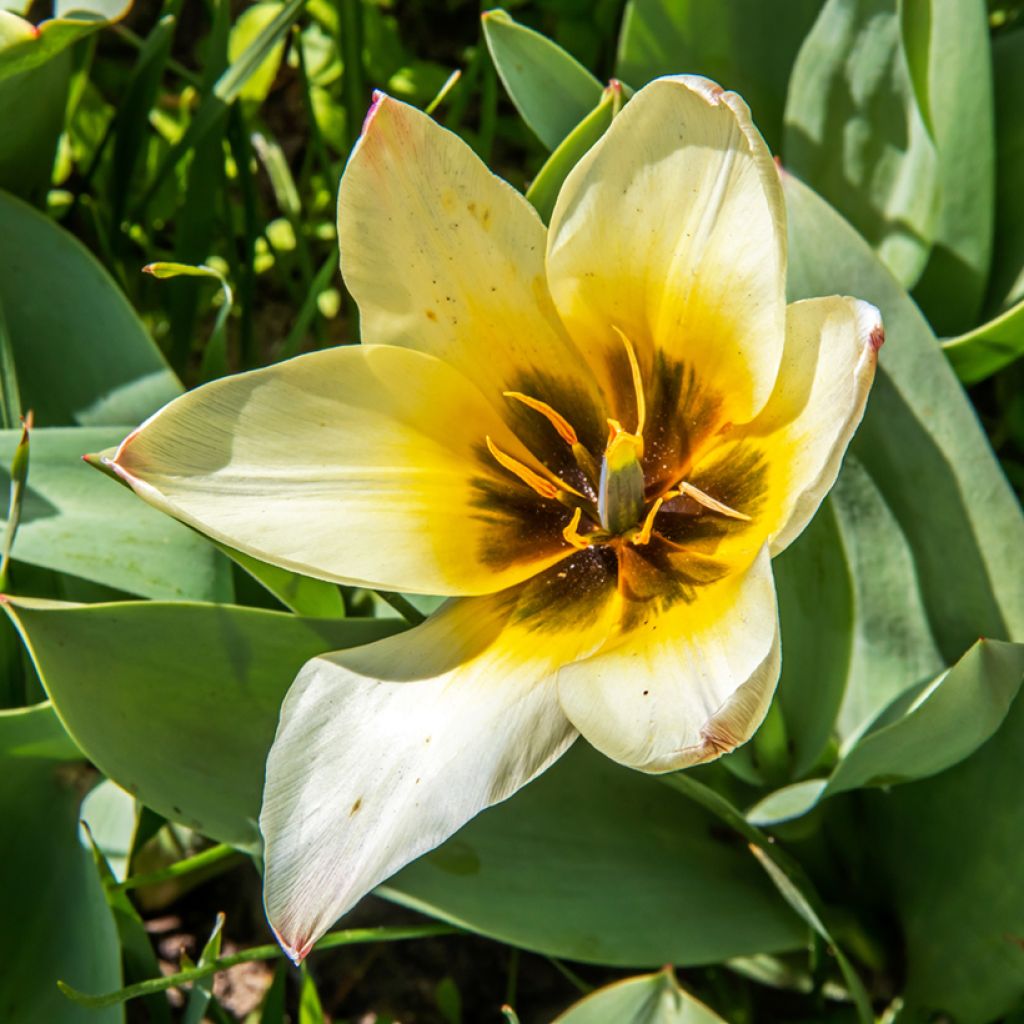

Tulipa greigii Albion Star


Tulipa greigii Albion Star
Tulipa greigii Albion Star
Tulipa greigii Albion Star
Greig's Tulip
This plant carries a 6 months recovery warranty
More information
We guarantee the quality of our plants for a full growing cycle, and will replace at our expense any plant that fails to recover under normal climatic and planting conditions.
From €5.90 for pickup delivery and €6.90 for home delivery
Express home delivery from €8.90.
Does this plant fit my garden?
Set up your Plantfit profile →
Description
The 'Albion Star' Botanical Tulip is a charming variety, initially pale and then more colourful when it opens and reveals its heart. It offers a soft shade, a slightly infused off-white with a touch of pink. The flower is disproportionate to the size of the plant and reaches up to 12 cm in diameter when open, revealing black, red, and yellow markings in the centre. The flowers emerge from a pale grey-green, slightly streaked foliage and there are three or four per stem.
Belonging to the Liliaceae family, greigii Tulips have attractive characteristics: they are small, reaching about twenty centimetres and are therefore placed at the edge of paths, but also in rockeries, along with all the early small bulbs. These tulips do not disappear after a few years of cultivation. More perennial than horticultural tulips, they renew the charm of spring for a longer period. Originating from Central Asia, they are hardy and robust and are suitable for many climates. They appreciate a rather well-drained soil and can be satisfied with a low-nutrient substrate.
'Albion Star' reaches a height of 25 to 30 cm. It will also thrive in pots or hanging baskets, to brighten up window sills and terraces in spring compositions. 'Albion Star' has beautiful oblong, green, 10-15 cm wide, thick, and, of course, sheathing leaves. From March, beautiful corollas unfold in a range of light and tender shades. Perched on a sturdy stem, the cup is formed by tepals ending in a point, with a base colour of off-white. Depending on the maturity of the flower, it takes on light pink nuances. When the flower is fully open, it reveals intense shades: black, red, and yellow markings in the centre.
Paired with brightly coloured spring bulbs, the 'Albion Star' greigii Tulip is a delight for the eyes at the end of winter. Its reasonable size allows it to sneak into rockeries, but also in containers to tenderly welcome March. Easy, sturdy, and low-maintenance, it reappears vigorously every year and allows for staggered flowering with Crocus, Muscari, and Daffodils in refined and delicate compositions.
Report an error about the product description
Tulipa greigii Albion Star in pictures


Plant habit
Flowering
Foliage
Botanical data
Tulipa
greigii
Albion Star
Liliaceae
Greig's Tulip
Cultivar or hybrid
Planting and care
Plant the bulbs of 'Albion Star' greigii Tulips in autumn, from September to December, spacing them 5 to 10 cm apart, at a depth of 10 cm (Bulbs should be covered with twice their height of soil). You can place them in the ground or in a container. They will also appreciate a rockery in a non-scorching exposure.
Plant in ordinary, slightly acidic, neutral, or slightly chalky, loose, well-worked, and well-draining soil. Never add poorly decomposed manure or compost to the planting soil, as this could cause the bulbs to rot. Also, avoid bulbs touching each other. The greigii tulip will grow well in moist to dry soil in a sunny or even semi-shaded exposure.
After flowering, their faded foliage becomes unsightly, so we recommend planting Heucheras, Tiarelles, or Brunneras in the foreground of your flower beds. Their foliage will enhance the colours of your tulips and they will elegantly hide their yellowed leaves. To prevent the bulb from exhausting itself, it is a good idea to cut the stems of the faded flowers.
Planting period
Intended location
Care
This item has not been reviewed yet - be the first to leave a review about it.
Haven't found what you were looking for?
Hardiness is the lowest winter temperature a plant can endure without suffering serious damage or even dying. However, hardiness is affected by location (a sheltered area, such as a patio), protection (winter cover) and soil type (hardiness is improved by well-drained soil).

Photo Sharing Terms & Conditions
In order to encourage gardeners to interact and share their experiences, Promesse de fleurs offers various media enabling content to be uploaded onto its Site - in particular via the ‘Photo sharing’ module.
The User agrees to refrain from:
- Posting any content that is illegal, prejudicial, insulting, racist, inciteful to hatred, revisionist, contrary to public decency, that infringes on privacy or on the privacy rights of third parties, in particular the publicity rights of persons and goods, intellectual property rights, or the right to privacy.
- Submitting content on behalf of a third party;
- Impersonate the identity of a third party and/or publish any personal information about a third party;
In general, the User undertakes to refrain from any unethical behaviour.
All Content (in particular text, comments, files, images, photos, videos, creative works, etc.), which may be subject to property or intellectual property rights, image or other private rights, shall remain the property of the User, subject to the limited rights granted by the terms of the licence granted by Promesse de fleurs as stated below. Users are at liberty to publish or not to publish such Content on the Site, notably via the ‘Photo Sharing’ facility, and accept that this Content shall be made public and freely accessible, notably on the Internet.
Users further acknowledge, undertake to have ,and guarantee that they hold all necessary rights and permissions to publish such material on the Site, in particular with regard to the legislation in force pertaining to any privacy, property, intellectual property, image, or contractual rights, or rights of any other nature. By publishing such Content on the Site, Users acknowledge accepting full liability as publishers of the Content within the meaning of the law, and grant Promesse de fleurs, free of charge, an inclusive, worldwide licence for the said Content for the entire duration of its publication, including all reproduction, representation, up/downloading, displaying, performing, transmission, and storage rights.
Users also grant permission for their name to be linked to the Content and accept that this link may not always be made available.
By engaging in posting material, Users consent to their Content becoming automatically accessible on the Internet, in particular on other sites and/or blogs and/or web pages of the Promesse de fleurs site, including in particular social pages and the Promesse de fleurs catalogue.
Users may secure the removal of entrusted content free of charge by issuing a simple request via our contact form.
The flowering period indicated on our website applies to countries and regions located in USDA zone 8 (France, the United Kingdom, Ireland, the Netherlands, etc.)
It will vary according to where you live:
- In zones 9 to 10 (Italy, Spain, Greece, etc.), flowering will occur about 2 to 4 weeks earlier.
- In zones 6 to 7 (Germany, Poland, Slovenia, and lower mountainous regions), flowering will be delayed by 2 to 3 weeks.
- In zone 5 (Central Europe, Scandinavia), blooming will be delayed by 3 to 5 weeks.
In temperate climates, pruning of spring-flowering shrubs (forsythia, spireas, etc.) should be done just after flowering.
Pruning of summer-flowering shrubs (Indian Lilac, Perovskia, etc.) can be done in winter or spring.
In cold regions as well as with frost-sensitive plants, avoid pruning too early when severe frosts may still occur.
The planting period indicated on our website applies to countries and regions located in USDA zone 8 (France, United Kingdom, Ireland, Netherlands).
It will vary according to where you live:
- In Mediterranean zones (Marseille, Madrid, Milan, etc.), autumn and winter are the best planting periods.
- In continental zones (Strasbourg, Munich, Vienna, etc.), delay planting by 2 to 3 weeks in spring and bring it forward by 2 to 4 weeks in autumn.
- In mountainous regions (the Alps, Pyrenees, Carpathians, etc.), it is best to plant in late spring (May-June) or late summer (August-September).
The harvesting period indicated on our website applies to countries and regions in USDA zone 8 (France, England, Ireland, the Netherlands).
In colder areas (Scandinavia, Poland, Austria...) fruit and vegetable harvests are likely to be delayed by 3-4 weeks.
In warmer areas (Italy, Spain, Greece, etc.), harvesting will probably take place earlier, depending on weather conditions.
The sowing periods indicated on our website apply to countries and regions within USDA Zone 8 (France, UK, Ireland, Netherlands).
In colder areas (Scandinavia, Poland, Austria...), delay any outdoor sowing by 3-4 weeks, or sow under glass.
In warmer climes (Italy, Spain, Greece, etc.), bring outdoor sowing forward by a few weeks.


































